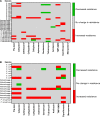Clinical and Molecular Analyses of Recurrent Gram-Negative Bloodstream Infections
- PMID: 35929656
- PMCID: PMC10169420
- DOI: 10.1093/cid/ciac638
Clinical and Molecular Analyses of Recurrent Gram-Negative Bloodstream Infections
Abstract
Background: The causes and clinical characteristics of recurrent gram-negative bacterial bloodstream infections (GNB-BSI) are poorly understood.
Methods: We used a cohort of patients with GNB-BSI to identify clinical characteristics, microbiology, and risk factors associated with recurrent GNB-BSI. Bacterial genotyping (pulsed-field gel electrophoresis [PFGE] and whole-genome sequencing [WGS]) was used to determine whether episodes were due to relapse or reinfection. Multivariable logistic regression was used to identify risk factors for recurrence.
Results: Of the 1423 patients with GNB-BSI in this study, 60 (4%) had recurrent GNB-BSI. Non-White race (odds ratio [OR], 2.35; 95% confidence interval [CI], 1.38-4.01; P = .002), admission to a surgical service (OR, 2.18; 95% CI, 1.26-3.75; P = .005), and indwelling cardiac device (OR, 2.73; 95% CI, 1.21-5.58; P = .009) were associated with increased risk for recurrent GNB-BSI. Among the 48 patients with recurrent GNB-BSI whose paired bloodstream isolates underwent genotyping, 63% were due to relapse (30 of 48) and 38% were due to reinfection (18 of 48) based on WGS. Compared with WGS, PFGE correctly differentiated relapse and reinfection in 98% (47 of 48) of cases. Median time to relapse and reinfection was similar (113 days; interquartile range [IQR], 35-222 vs 174 days; IQR, 69-599; P = .13). Presence of a cardiac device was associated with relapse (relapse: 7 of 27, 26%; nonrelapse: 65 of 988, 7%; P = .002).
Conclusions: In this study, recurrent GNB-BSI was most commonly due to relapse. PFGE accurately differentiated relapse from reinfection when compared with WGS. Cardiac device was a risk factor for relapse.
Keywords: bacteremia; bloodstream infection; gram-negative; recurrent.
© The Author(s) 2022. Published by Oxford University Press on behalf of Infectious Diseases Society of America. All rights reserved. For permissions, please e-mail: journals.permissions@oup.com.
Conflict of interest statement
Potential conflicts of interest. V. G. F. reports personal fees from Novartis, Novadigm, Durata, Debiopharm, Genentech, Achaogen, Affinium, Medicines Co, Cerexa, Tetraphase, Trius, MedImmune, Bayer, Theravance, Basilea, Affinergy, Janssen, xBiotech, Contrafect, Regeneron, Basilea, Destiny, Amphliphi Biosciences, Integrated Biotherapeutics, Armata, Valnbio, Akagera, Aridis, Roche, Pfizer, and C3J; grants from NIH, MedImmune, Cerexa/Forest/Actavis/Allergan, Pfizer, Advanced Liquid Logics, Theravance, Novartis, Cubist/Merck, Medical Biosurfaces, Locus, Affinergy, Contrafect, Karius, Genentech, Regeneron, Basilea, Janssen, Green Cross, Cubist, Cerexa, Durata, Theravance, and Debiopharm; royalties from UpToDate; a patent pending in sepsis diagnostics; support from Contrafect to present phase 2 data at 2019 European Congress of Clinical Microbiology and Infectious Diseases (ECCMID); serving as associate editor, Clinical Infectious Diseases; and stock or stock options to self from ArcBio and Valanbio. J. T. T. is a scientific advisor for Resonantia, Inc. C. A. A. reports grant support from Merck Pharmaceuticals, Entasis Pharmaceuticals and MeMed Diagnostics, and Harris County Public Health; payments made to the institution during the conduct of this study from NIH/NIAID ARLG UM1AI104681, NIH/NIAID T32 AI141349, NIH/NIAID U19 AI144297, NIH/NIAID R01 AI150685, and NIH/NIAID R21 AI151536; royalties or licenses from UpToDate paid to self; reimbursements to attend IDWeek as speaker and part of the organizing committee from the Infectious Diseases Society of America, to attend ASMMicrobe as speaker from American Society for Microbiology, to attend the Society for Healthcare Epidemiology of America (SHEA) Conference as speaker from Society of Hospital Epidemiology of America, to attend ECCMID as speaker from the European Society for Clinical Microbiology and Infectious Diseases, to attend the Interdisciplinary Course on Antibiotics and Resistance (ICARE) course as faculty from Merieux Foundation, and to attend annual meeting as speaker from Sociedad Argentina de Infectologia, Sociedad Chilena de Infectologia, Sociedad Colombiana de Infectologia, Panamerican Society for Infectious Diseases, and Brazilian Society for Infectious Diseases; participation on the World Health Organization’s Antibacterial Pipeline Advisory Group (received no financial compensation, no travel, meetings have all been virtual); payment made to self from NIH Grant Review Study Section; a voluntary position, no compensation, payment for travel and accommodation for board meetings as member of the Infectious Diseases Society of America Board of the Directors; and payment made to self as editor in chief, Antimicrobial Agents and Chemotherapy. All remaining authors: No reported conflicts of interest. All authors have submitted the ICMJE Form for Disclosure of Potential Conflicts of Interest. Conflicts that the editors consider relevant to the content of the manuscript have been disclosed.
Figures




References
-
- Gaynes R, Edwards JR, National Nosocomial Infections Surveillance System. Overview of nosocomial infections caused by gram-negative bacilli. Clin Infect Dis 2005; 41:848–54. - PubMed
-
- Wang W, Jiang T, Zhang W, et al. . Predictors of mortality in bloodstream infections caused by multidrug-resistant gram-negative bacteria: 4 years of collection. Am J Infect Control 2017; 45:59–64. - PubMed
-
- Al-Hasan MN, Lahr BD, Eckel-Passow JE, Baddour LM. Predictive scoring model of mortality in gram-negative bloodstream infection. Clin Microbiol Infect 2013; 19:948–54. - PubMed
Publication types
MeSH terms
Grants and funding
LinkOut - more resources
Full Text Sources
Medical

